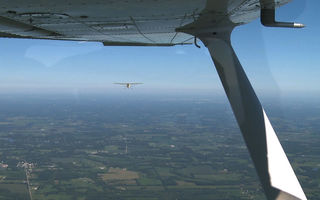For professionals who fly with precision and leave nothing to chance, Business Aviation leaders need to apply metrics in their managerial duties.
Conventional Wisdom has a quaint, comforting sound to it. Unfortunately, when challenged or tested, much of it can be found to be based on half-truths. Aviation is a science. Professional pilots pride themselves on the precision of their flying. The management of the flight departmental also requires precision. Thus, as an aviation manager, you should be looking for useful ways to measure your Flight Department’s performance and the value of the company aircraft as a business tool.
One area that is ideally suited for measurements is the maintenance condition of the aircraft. Today, Business Aviation recognizes the use of data tracking for maintenance. In fact, it is difficult to sell a turbine airplane that does not have some sort of electronic record keeping and maintenance reporting. For the aircraft and engines, we are moving toward measurements and data reporting in real-time.
The civil helicopter community has taken a leadership role in maintenance monitoring with Health and Usage Monitoring Systems, typically known as HUMS. With over a decade of experience, the civil helicopter industry has discovered that not only does aircraft reliability increase when aircraft condition is monitored, there also are benefits to safety and operational control too.
For example, Gulfstream’s PlaneConnect is an aircraft health, trend and monitoring system that collects reams of data on the aircraft’s status and datalinks that information to the maintenance team on the ground for analysis as the aircraft begins its descent for landing. Ground crews are aware of any issue that must be addressed prior to the aircraft’s next departure. Their latest version, introduced on the G650 series, the Health and Trend Monitoring (HTM) system anticipates when a part or component is nearing a maintenance review and sends the alerts its land-based technician.
Dassault Falcon is implementing a similar system with its newest models. The Falcon 6X will be equipped with an on-board self-diagnosis system called FalconScan, which will monitor the aircraft systems and collect about 10,000 parameters in real time. The technological advancement that has enabled monitoring of aircraft condition is the ability for near instant communication.
With the advancements in airborne connectivity, most turbine aircraft can have real-time data collection and reporting to the flight department.
But there are many more opportunities to make use of data in the management of the aviation operation. While quality control engineer and statistician W. Edward Deming is often credited with saying “What you don’t measure can’t be managed” (he didn’t), measurements for measurement’s sake leads to data overload and an inability to see the trends that matter. With regards to measurements, the corollary statement is, “If you step on the scale, you’d better do something about it.” Raw data without a system for analysis and a mindset to use the information data provide, are of little value.
Data-based management starts at the top. A corporation thrives on profit and loss. Management has a number of metrics that indicate not only the current profitability of the company, but trends that will affect long-term profitability. To be useful, a metric needs to be tailored to the business function, or in our case, the aviation business function.
Business Aviation is a means of transportation for the firm’s personnel and clients. As such, immediately after safety, service should be your Flight Department’s top priority. With safety, accidents are a terrible measure, but they are indeed a metric. Organizations that value safety seek smaller measures like incidents as well as counting or measuring processes and procedures that are not followed properly, to track their quest for safe operations. Using such measures, intervention can be instituted before tragedy happens.
The level of service provided extends beyond hours flown and passengers carried. Things like denied trip requests and days the aircraft is unavailable due to maintenance can lead to a discussion of whether the current aircraft is adequate or whether it is time for another aircraft. Tracking sales made by passengers flown on the business aircraft as well as new contracts signed as a result of meeting with clients also are very important metrics of a business aircraft’s usefulness.
There are other ways to develop and maintain various metrics to improve the levels of service as well as better manage costs. Measuring things such as staffing, additional duties, and days away from home can provide both efficiency metrics and be an leading indicator for turnover.
Organizations like the National Business Aviation Association and Helicopter Association International are supporting these measurements though education and industry cooperatives. The leadership of this effort comes from forward-looking aviation managers who understand and support the needs of the corporation.
There are many different measure of success. Choose ones that fir both your operation and what it is that you want to measure. More on that later...
David Wyndham - David joined Conklin & de Decker in 1993. His primary responsibilities include developing and managing new programs for the company, conducting consulting studies, managing aircraft cost and performance databases, and providing customer computer support.





